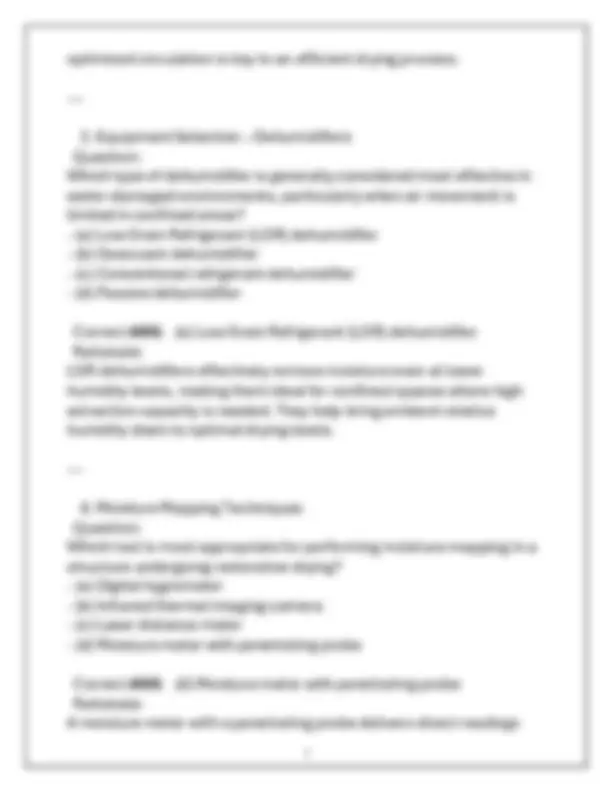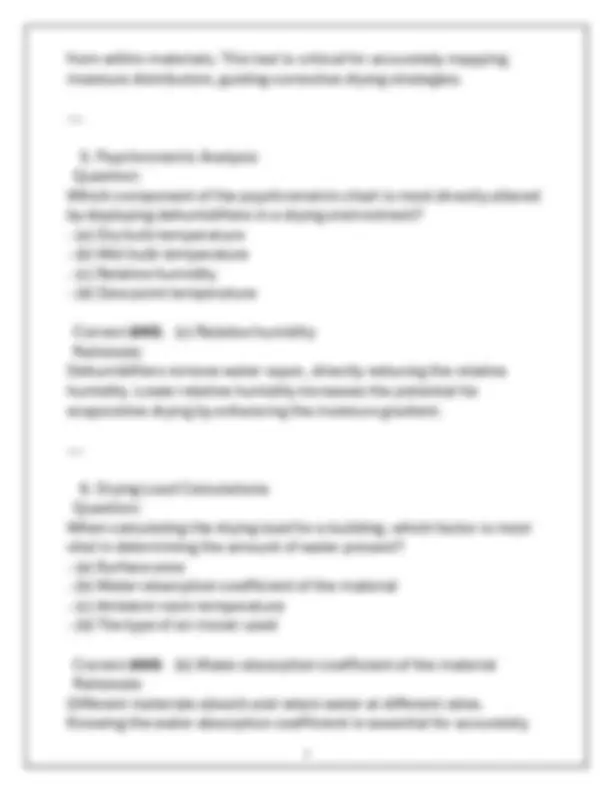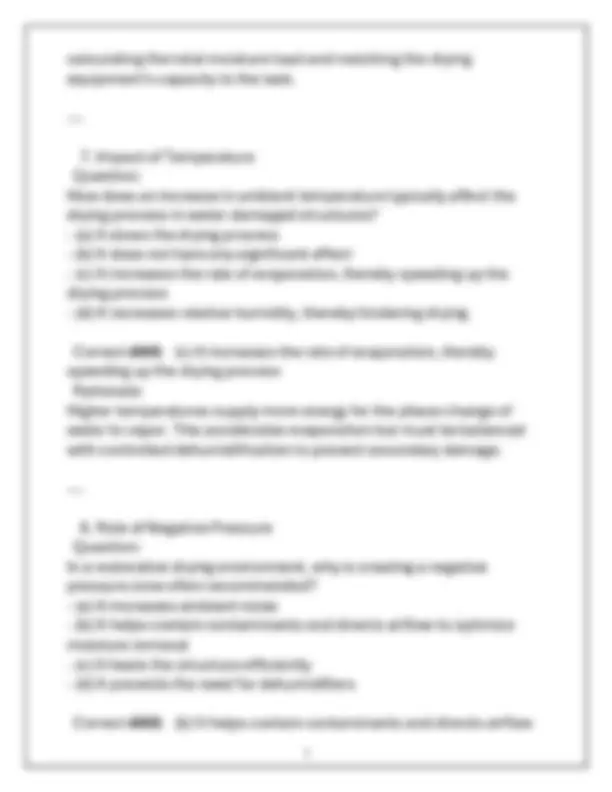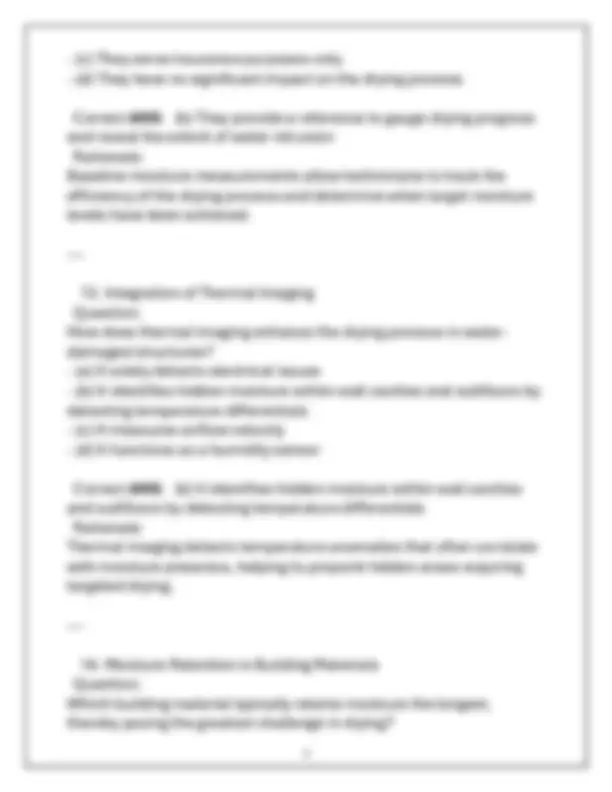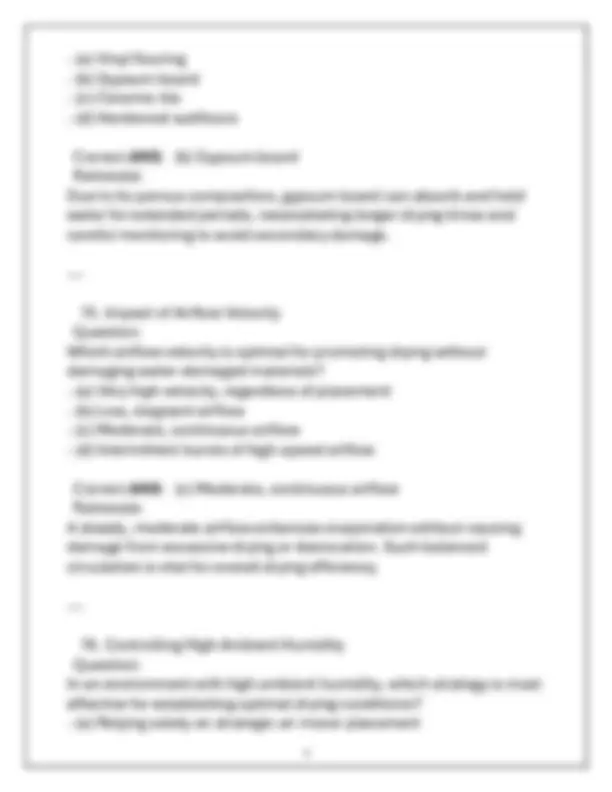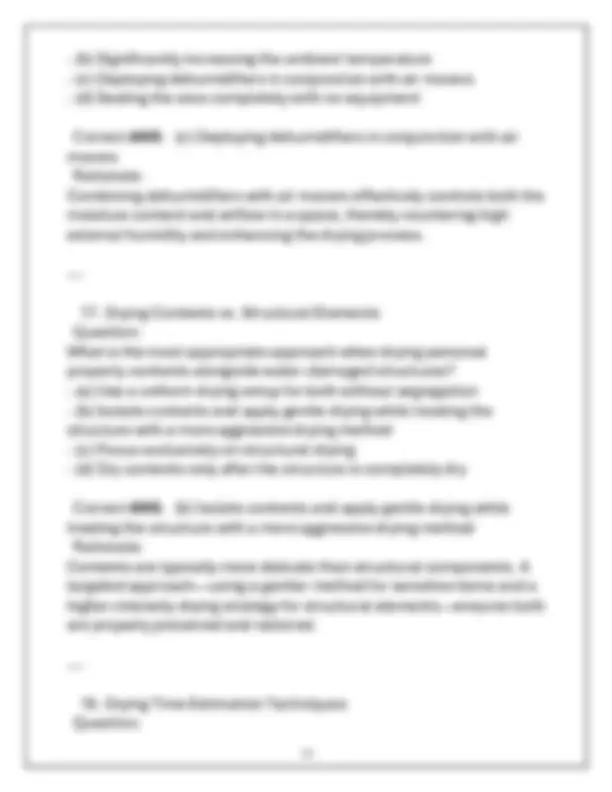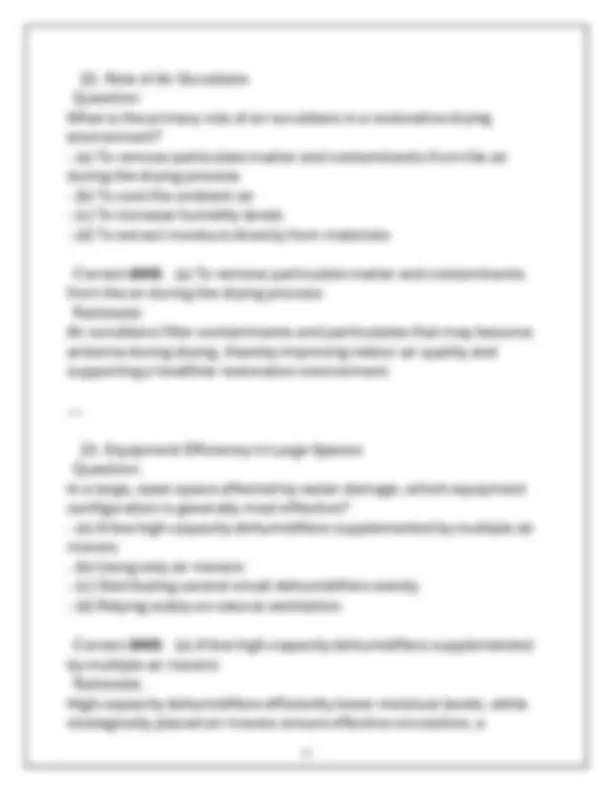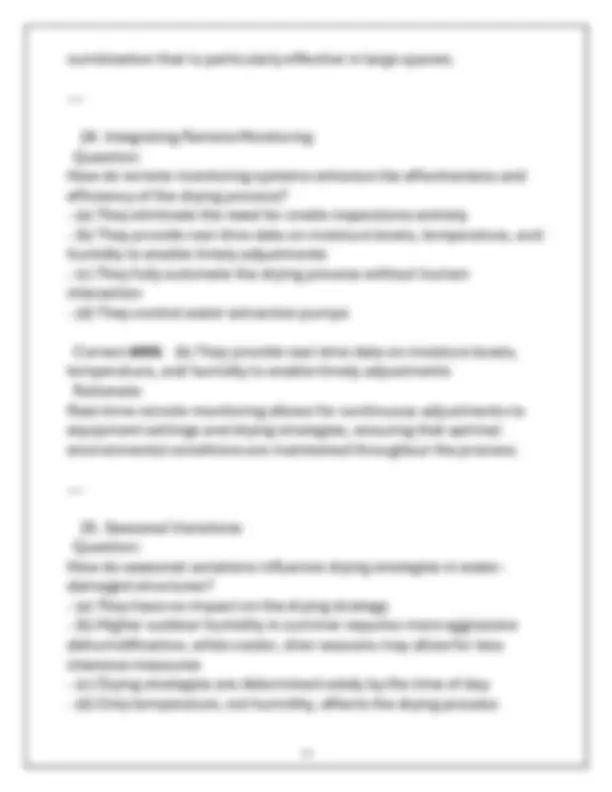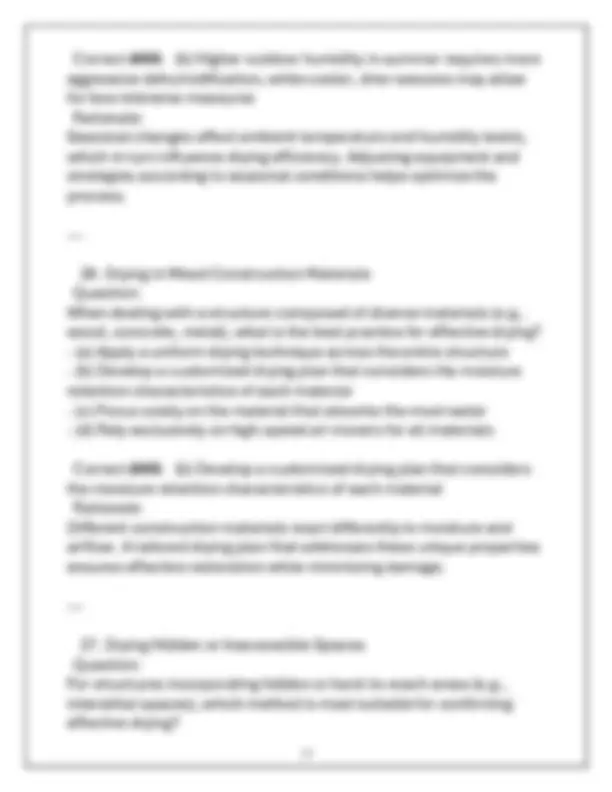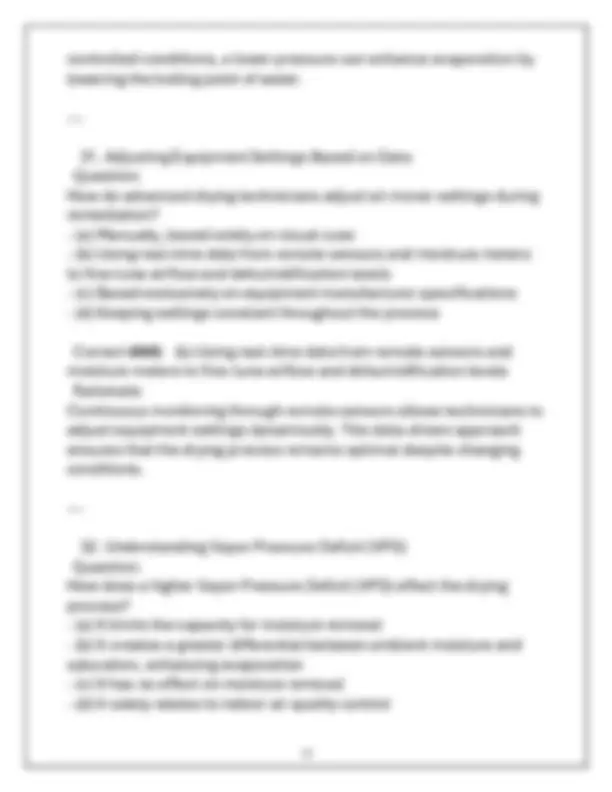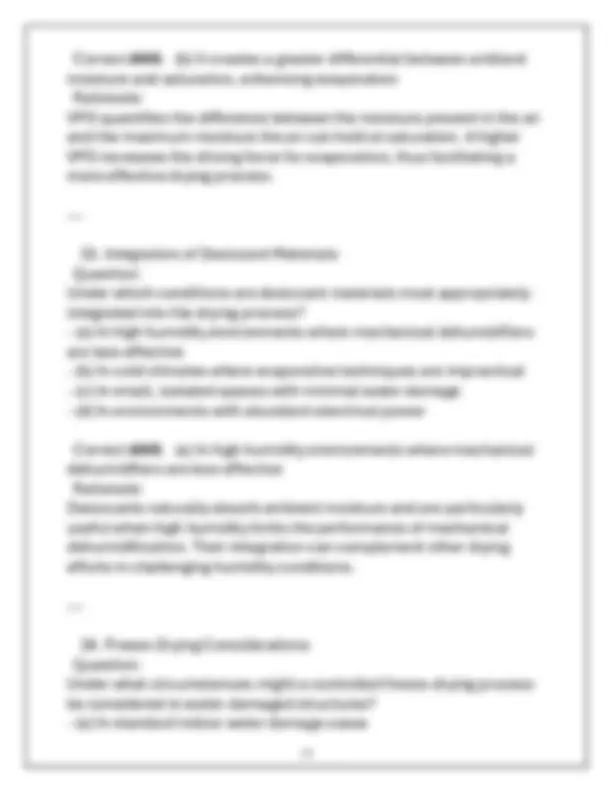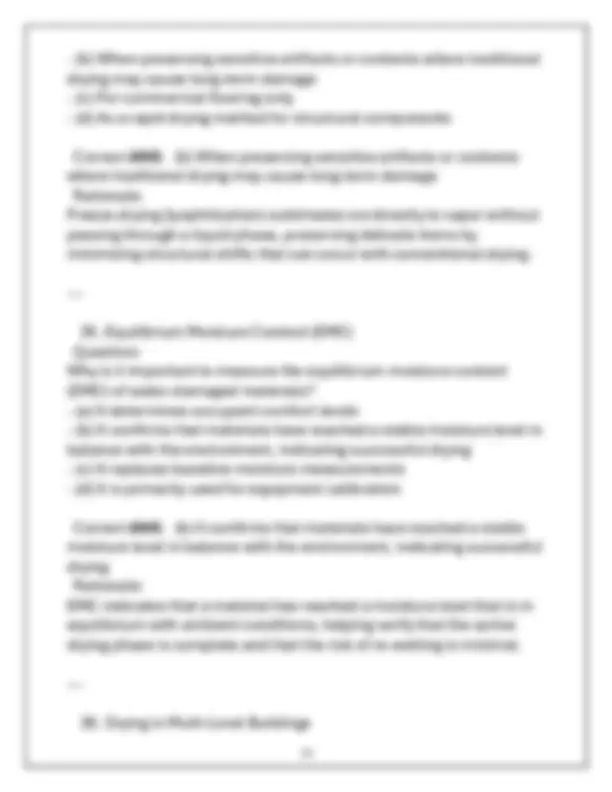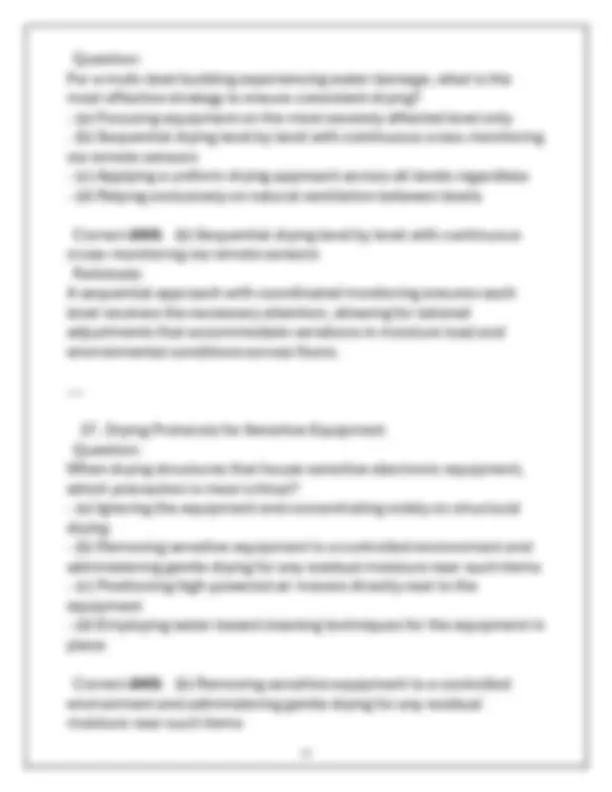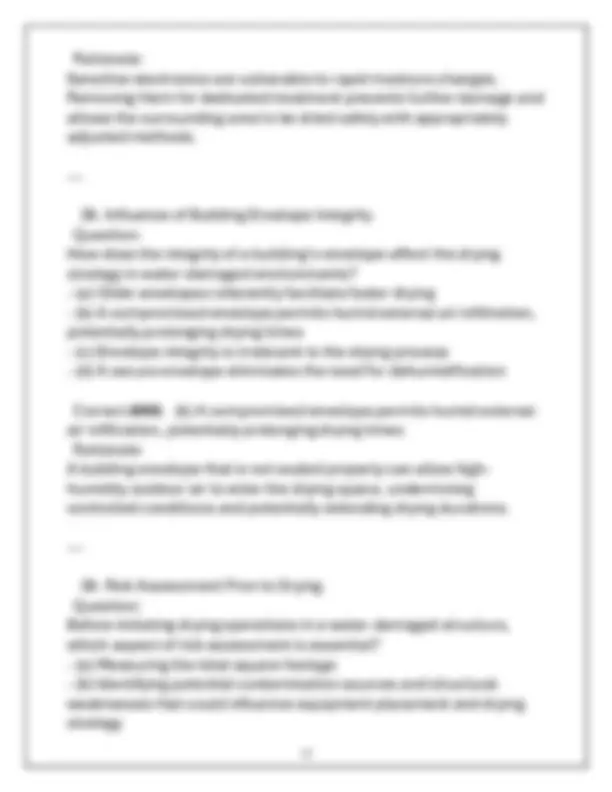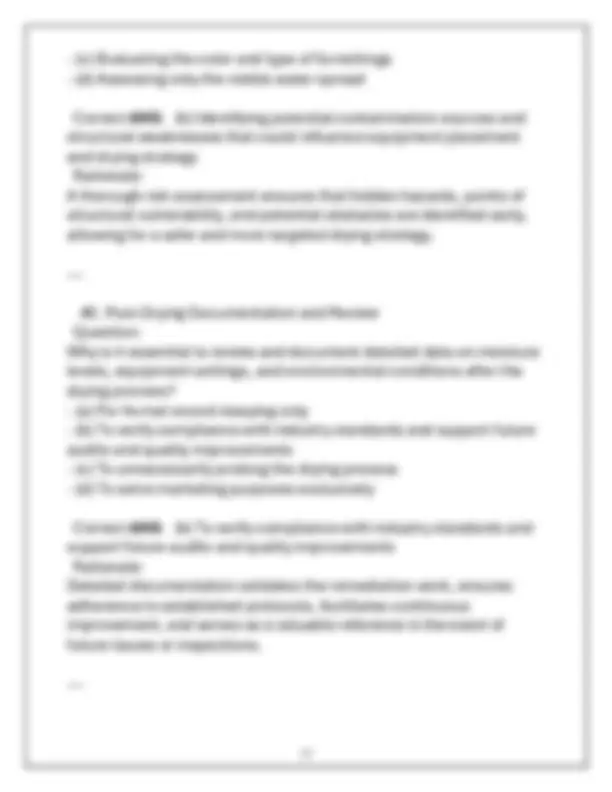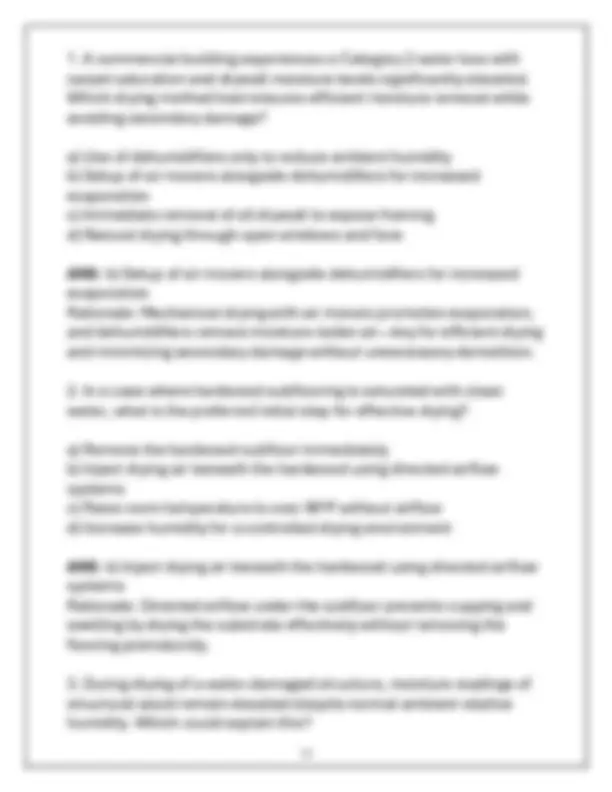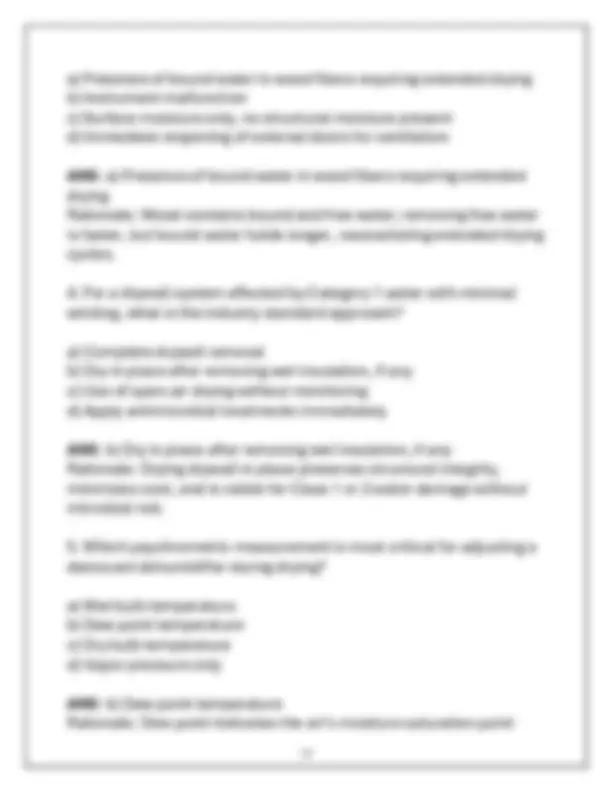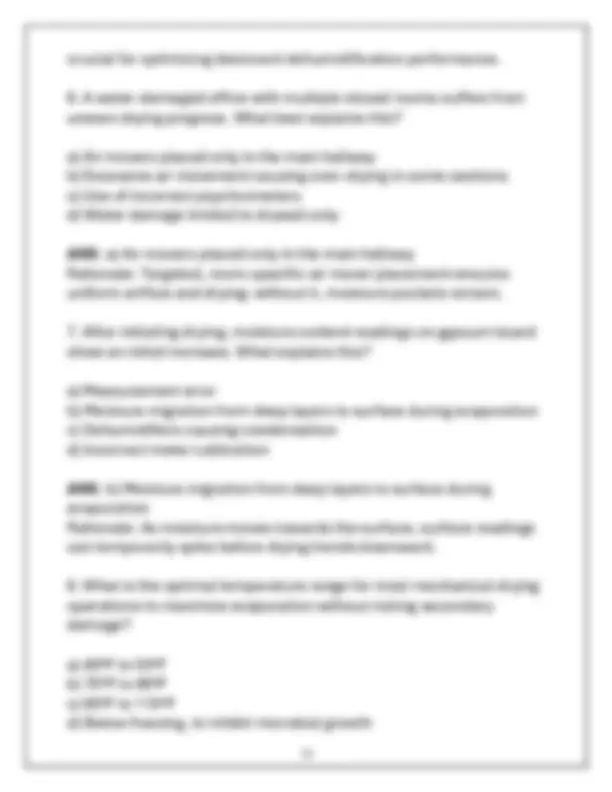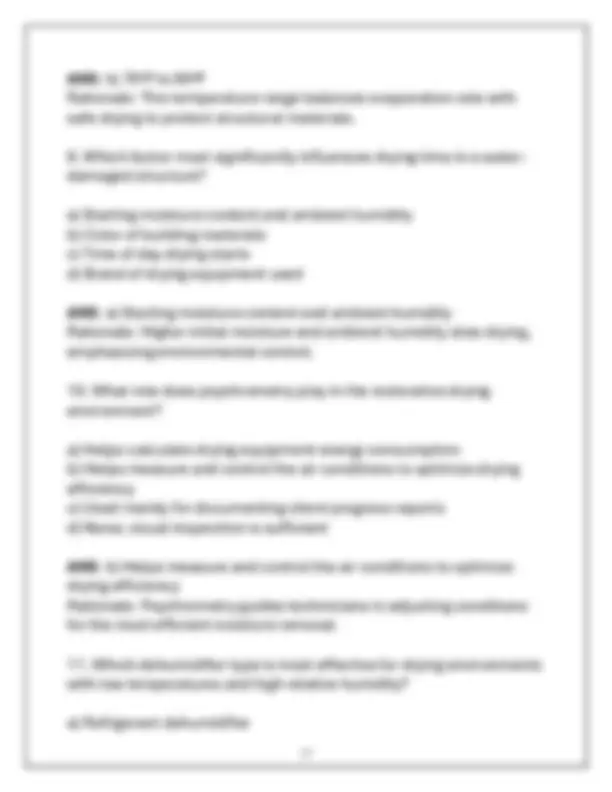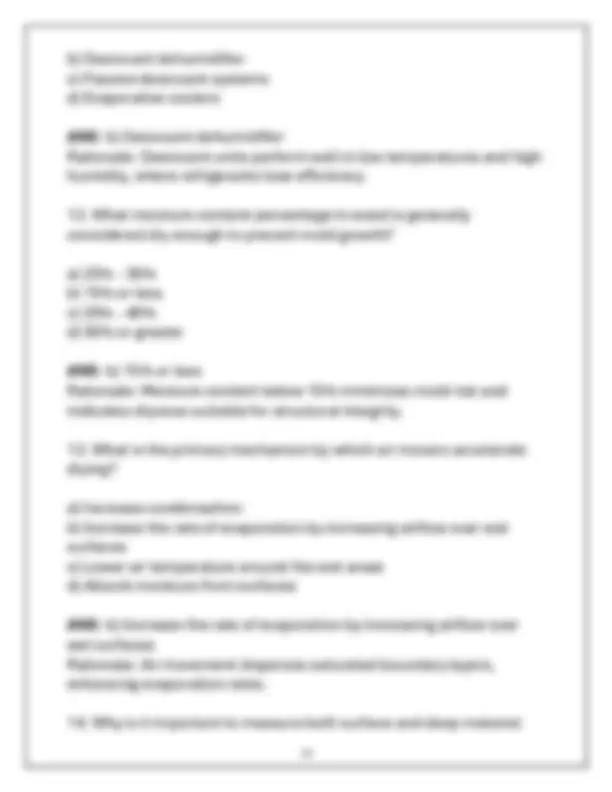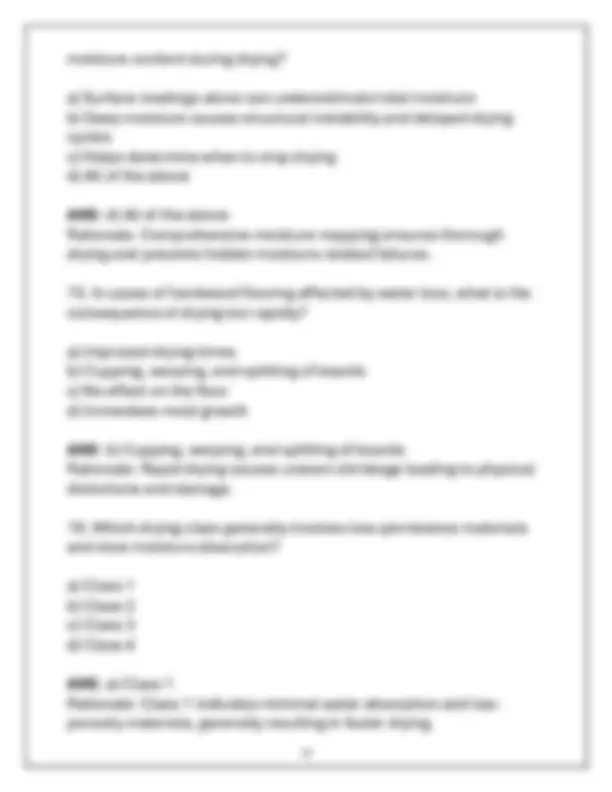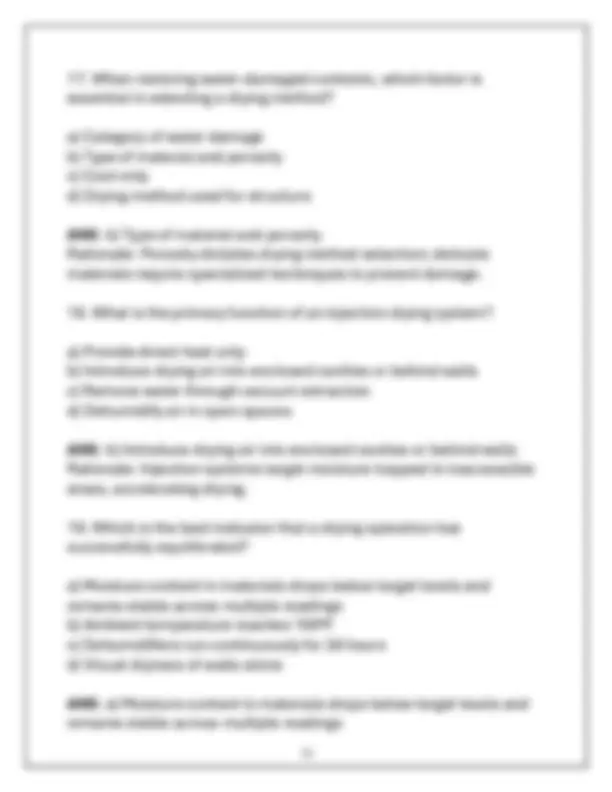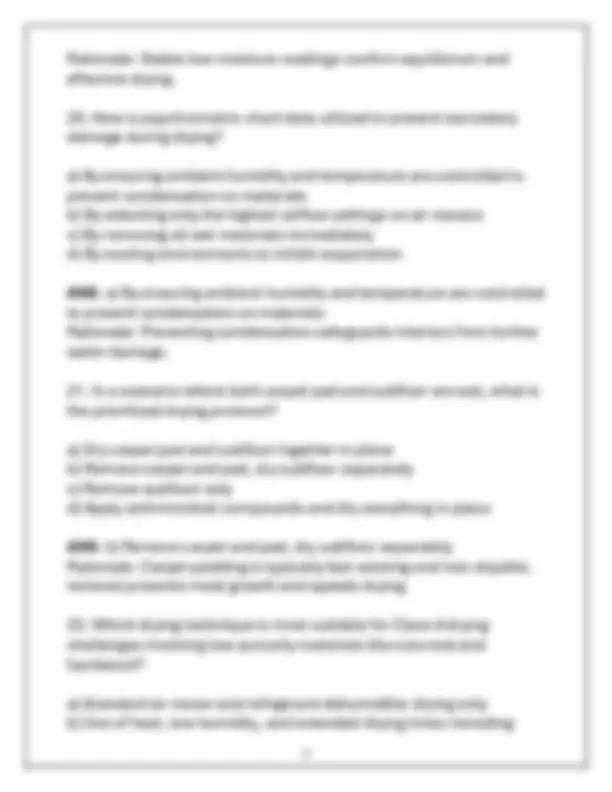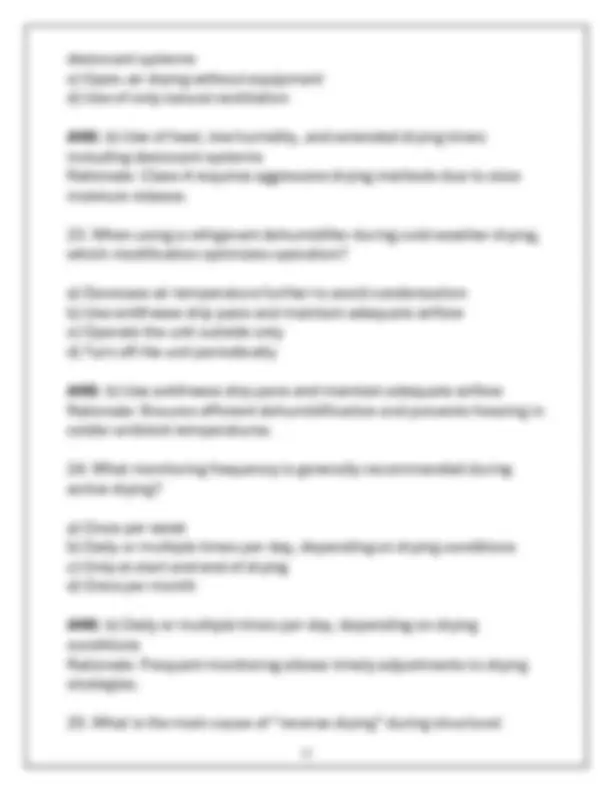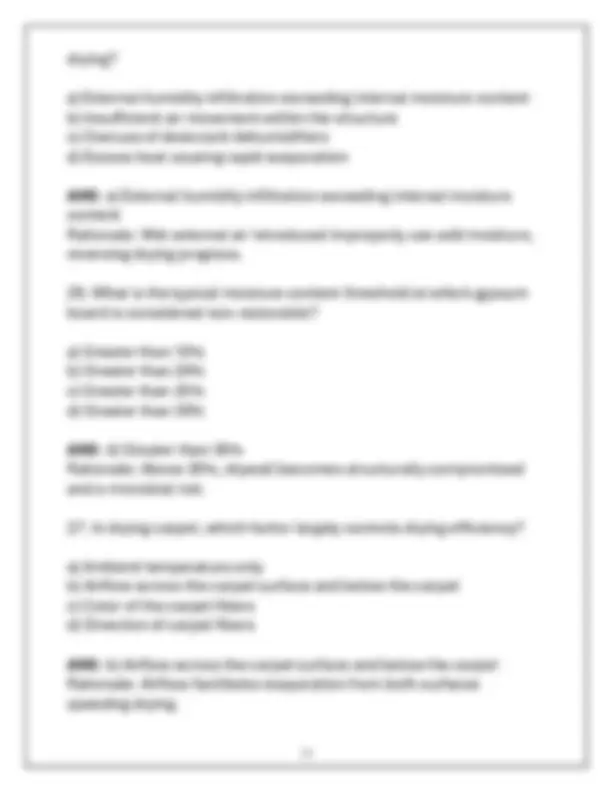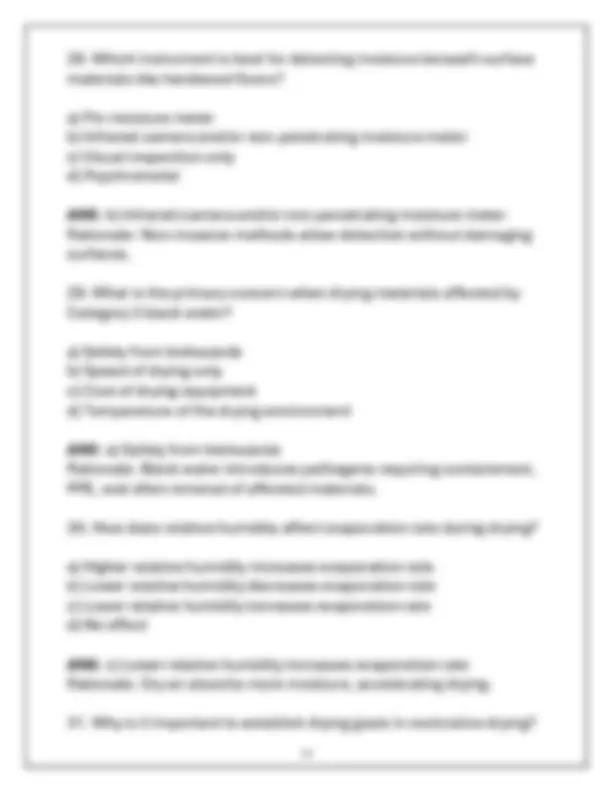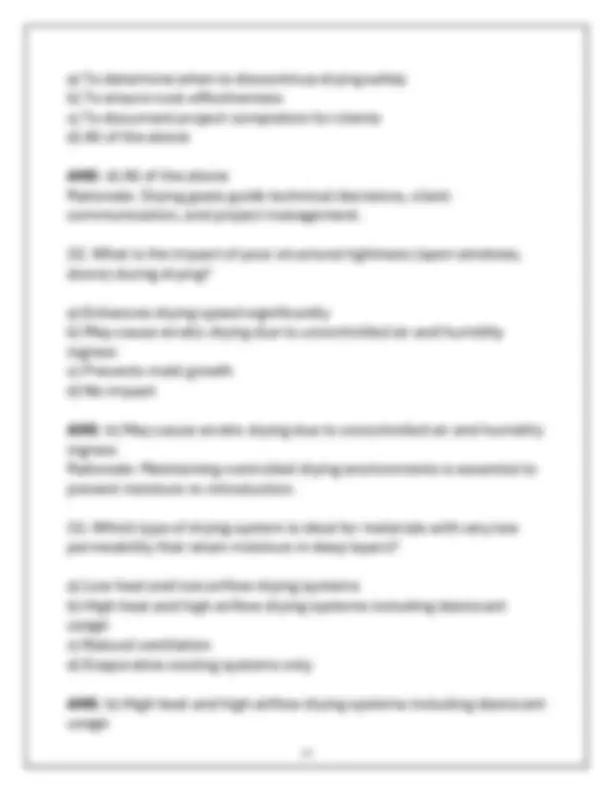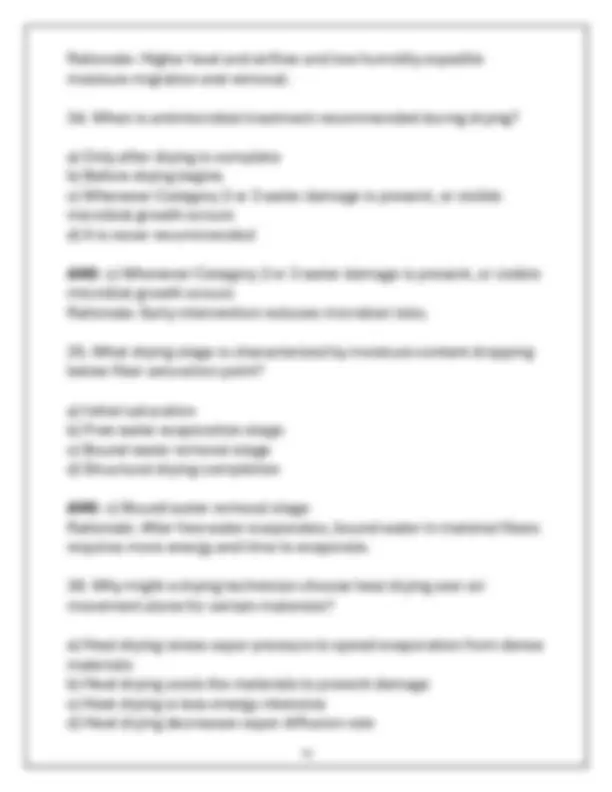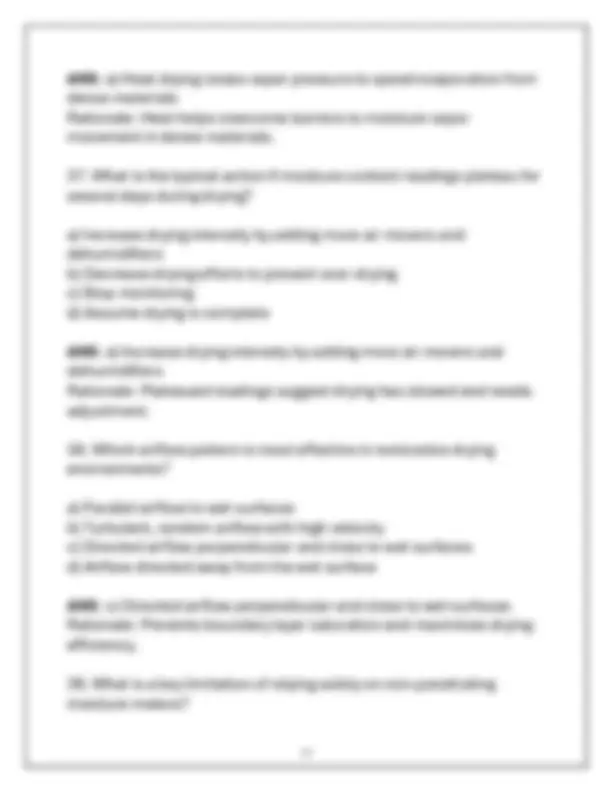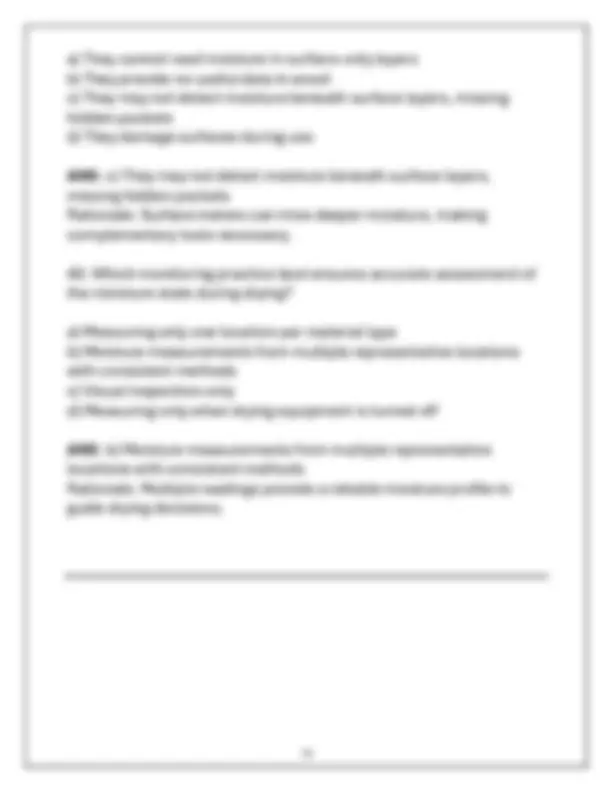Download Applied Structural Drying Technician - Final Assessment Review - IICRC 2025 and more Exams Advanced Education in PDF only on Docsity!
Applied Structural Drying Technician
Final Assessment Review
(Questions & Solutions)
- Drying Mechanism Fundamentals Question: Which phenomenon is the primary mechanism that drives the removal of moisture from water-damaged materials in structural drying?
- (a) Diffusion
- (b) Evaporation
- (c) Conduction
- (d) Radiation Correct ANS : (b) Evaporation Rationale: Evaporation is the process of converting liquid water into vapor. In water-damaged environments, evaporation is influenced by factors such as temperature, air movement, and relative humidity, making it the fundamental process exploited in drying.
- Role of Air Movers Question: In a restorative drying environment, which function of air movers is most critical to facilitate efficient drying?
- (a) Cooling down the area
- (b) Promoting evaporation by circulating air over wet surfaces
- (c) Reducing dust levels in the environment
- (d) Increasing ambient noise to disrupt condensation Correct ANS : (b) Promoting evaporation by circulating air over wet surfaces Rationale: Air movers create airflow that replaces moisture-laden air with drier air, thereby accelerating evaporation from wet surfaces. This
from within materials. This tool is critical for accurately mapping moisture distribution, guiding corrective drying strategies.
- Psychrometric Analysis Question: Which component of the psychrometric chart is most directly altered by deploying dehumidifiers in a drying environment?
- (a) Dry bulb temperature
- (b) Wet bulb temperature
- (c) Relative humidity
- (d) Dew point temperature Correct ANS : (c) Relative humidity Rationale: Dehumidifiers remove water vapor, directly reducing the relative humidity. Lower relative humidity increases the potential for evaporative drying by enhancing the moisture gradient.
- Drying Load Calculations Question: When calculating the drying load for a building, which factor is most vital in determining the amount of water present?
- (a) Surface area
- (b) Water absorption coefficient of the material
- (c) Ambient room temperature
- (d) The type of air mover used Correct ANS : (b) Water absorption coefficient of the material Rationale: Different materials absorb and retain water at different rates. Knowing the water absorption coefficient is essential for accurately
calculating the total moisture load and matching the drying equipment’s capacity to the task.
- Impact of Temperature Question: How does an increase in ambient temperature typically affect the drying process in water-damaged structures?
- (a) It slows the drying process
- (b) It does not have any significant effect
- (c) It increases the rate of evaporation, thereby speeding up the drying process
- (d) It increases relative humidity, thereby hindering drying Correct ANS : (c) It increases the rate of evaporation, thereby speeding up the drying process Rationale: Higher temperatures supply more energy for the phase change of water to vapor. This accelerates evaporation but must be balanced with controlled dehumidification to prevent secondary damage.
- Role of Negative Pressure Question: In a restorative drying environment, why is creating a negative pressure zone often recommended?
- (a) It increases ambient noise
- (b) It helps contain contaminants and directs airflow to optimize moisture removal
- (c) It heats the structure efficiently
- (d) It prevents the need for dehumidifiers Correct ANS : (b) It helps contain contaminants and directs airflow
- (d) Placement near windows Correct ANS : (b) Creating a diagonal airflow pattern over wet areas Rationale: A diagonal airflow pattern increases the opportunity for moisture to be carried away from wet surfaces, thereby maximizing evaporative efficiency and reducing drying times.
11. Evaporative vs. Extractive Drying Question:
In a scenario where surface water is minimal but moisture remains embedded within porous materials, which drying method is most effective?
- (a) Evaporative drying
- (b) Extractive drying
- (c) Both methods are equally effective
- (d) Neither method is sufficient Correct ANS : (a) Evaporative drying Rationale: Evaporative drying draws moisture from within porous substrates to the surface, where it can then vaporize. This method is particularly effective when the surface water has been largely removed.
12. Importance of Baseline Measurements Question:
Why are baseline moisture readings critical before commencing any drying operation?
- (a) They help justify remediation costs
- (b) They provide a reference to gauge drying progress and reveal the extent of water intrusion
- (c) They serve insurance purposes only
- (d) They have no significant impact on the drying process Correct ANS : (b) They provide a reference to gauge drying progress and reveal the extent of water intrusion Rationale: Baseline moisture measurements allow technicians to track the efficiency of the drying process and determine when target moisture levels have been achieved.
13. Integration of Thermal Imaging Question:
How does thermal imaging enhance the drying process in water- damaged structures?
- (a) It solely detects electrical issues
- (b) It identifies hidden moisture within wall cavities and subfloors by detecting temperature differentials
- (c) It measures airflow velocity
- (d) It functions as a humidity sensor Correct ANS : (b) It identifies hidden moisture within wall cavities and subfloors by detecting temperature differentials Rationale: Thermal imaging detects temperature anomalies that often correlate with moisture presence, helping to pinpoint hidden areas requiring targeted drying.
14. Moisture Retention in Building Materials Question:
Which building material typically retains moisture the longest, thereby posing the greatest challenge in drying?
- (b) Significantly increasing the ambient temperature
- (c) Deploying dehumidifiers in conjunction with air movers
- (d) Sealing the area completely with no equipment Correct ANS : (c) Deploying dehumidifiers in conjunction with air movers Rationale: Combining dehumidifiers with air movers effectively controls both the moisture content and airflow in a space, thereby countering high external humidity and enhancing the drying process.
17. Drying Contents vs. Structural Elements Question:
What is the most appropriate approach when drying personal property contents alongside water-damaged structures?
- (a) Use a uniform drying setup for both without segregation
- (b) Isolate contents and apply gentle drying while treating the structure with a more aggressive drying method
- (c) Focus exclusively on structural drying
- (d) Dry contents only after the structure is completely dry Correct ANS : (b) Isolate contents and apply gentle drying while treating the structure with a more aggressive drying method Rationale: Contents are typically more delicate than structural components. A targeted approach—using a gentler method for sensitive items and a higher-intensity drying strategy for structural elements—ensures both are properly preserved and restored.
18. Drying Time Estimation Techniques Question:
Which method is commonly used for estimating drying time in water- damaged structures?
- (a) Solely relying on visual inspections
- (b) Plotting drying curves from periodic moisture readings
- (c) Relying exclusively on ambient temperature measurements
- (d) Estimating based on material age Correct ANS : (b) Plotting drying curves from periodic moisture readings Rationale: Regular moisture readings plotted over time provide quantitative drying curves that enable technicians to estimate drying duration and adjust strategies as needed.
19. Interpreting Moisture Meter Readings Question:
What does a moisture meter reading that deviates from the expected range for a given material post-drying indicate?
- (a) Temporary ambient temperature fluctuations
- (b) Incomplete drying or potential re-wetting
- (c) Equipment malfunction exclusively
- (d) Completion of the drying process Correct ANS : (b) Incomplete drying or potential re-wetting Rationale: Unexpected moisture levels suggest that the drying process may not have been entirely effective or that re-wetting has occurred. This triggers a re-evaluation of equipment placement or drying duration.
20. Balanced Air Circulation Question:
- Role of Air Scrubbers Question: What is the primary role of air scrubbers in a restorative drying environment?
- (a) To remove particulate matter and contaminants from the air during the drying process
- (b) To cool the ambient air
- (c) To increase humidity levels
- (d) To extract moisture directly from materials Correct ANS : (a) To remove particulate matter and contaminants from the air during the drying process Rationale: Air scrubbers filter contaminants and particulates that may become airborne during drying, thereby improving indoor air quality and supporting a healthier restoration environment.
- Equipment Efficiency in Large Spaces Question: In a large, open space affected by water damage, which equipment configuration is generally most effective?
- (a) A few high-capacity dehumidifiers supplemented by multiple air movers
- (b) Using only air movers
- (c) Distributing several small dehumidifiers evenly
- (d) Relying solely on natural ventilation Correct ANS : (a) A few high-capacity dehumidifiers supplemented by multiple air movers Rationale: High-capacity dehumidifiers efficiently lower moisture levels, while strategically placed air movers ensure effective circulation, a
combination that is particularly effective in large spaces.
- Integrating Remote Monitoring Question: How do remote monitoring systems enhance the effectiveness and efficiency of the drying process?
- (a) They eliminate the need for onsite inspections entirely
- (b) They provide real-time data on moisture levels, temperature, and humidty to enable timely adjustments
- (c) They fully automate the drying process without human interaction
- (d) They control water extraction pumps Correct ANS : (b) They provide real-time data on moisture levels, temperature, and humidty to enable timely adjustments Rationale: Real-time remote monitoring allows for continuous adjustments to equipment settings and drying strategies, ensuring that optimal environmental conditions are maintained throughout the process.
- Seasonal Variations Question: How do seasonal variations influence drying strategies in water- damaged structures?
- (a) They have no impact on the drying strategy
- (b) Higher outdoor humidity in summer requires more aggressive dehumidification, while cooler, drier seasons may allow for less intensive measures
- (c) Drying strategies are determined solely by the time of day
- (d) Only temperature, not humidity, affects the drying process
- (a) Relying solely on surface moisture measurements
- (b) Utilizing invasive measurement tools such as probe meters or sampling devices
- (c) Using visual inspection alone
- (d) Assuming efficacy based on ambient readings only Correct ANS : (b) Utilizing invasive measurement tools such as probe meters or sampling devices Rationale: Hidden spaces may harbor moisture undetectable by surface inspections. Invasive measurements provide critical data to verify that these areas have been effectively dried.
28. Sequence of Drying Operations Question:
Which sequence of operations is most effective for ensuring timely drying of water-damaged structures?
- (a) Assessment and planning, followed by aggressive drying, continuous monitoring, and final verification
- (b) Immediate equipment placement without prior assessment
- (c) Drying without planning and retrospectively verifying results
- (d) Delaying drying until contents are removed Correct ANS : (a) Assessment and planning, followed by aggressive drying, continuous monitoring, and final verification Rationale: A systematic approach starting with a thorough assessment and planning phase ensures that equipment is optimally deployed and that drying progress is continuously verified for efficiency and effectiveness.
- Environmental Control in Drying Question: Why is it essential to control ambient environmental factors in a restorative drying environment?
- (a) To prevent equipment from overheating
- (b) To minimize additional water intrusion
- (c) To ensure temperature, humidity, and airflow are optimized for maximum evaporation
- (d) To limit the duration of the structural drying phase Correct ANS : (c) To ensure temperature, humidity, and airflow are optimized for maximum evaporation Rationale: By controlling key ambient factors, technicians maximize the evaporation rate and overall drying efficiency, reducing the likelihood of prolonged moisture presence and subsequent damage.
- Impact of Ambient Pressure Question: How does ambient pressure influence the drying process in water- damaged structures?
- (a) Lower ambient pressure can reduce the boiling point of water, potentially enhancing drying under controlled conditions
- (b) It has no impact on the drying process
- (c) Higher ambient pressure speeds up the drying process
- (d) Ambient pressure only affects drying in outdoor environments Correct ANS : (a) Lower ambient pressure can reduce the boiling point of water, potentially enhancing drying under controlled conditions Rationale: Although not typically a primary control in water restoration, ambient pressure can influence phase change dynamics. Under specific
Correct ANS : (b) It creates a greater differential between ambient moisture and saturation, enhancing evaporation Rationale: VPD quantifies the difference between the moisture present in the air and the maximum moisture the air can hold at saturation. A higher VPD increases the driving force for evaporation, thus facilitating a more effective drying process.
- Integration of Desiccant Materials Question: Under which conditions are desiccant materials most appropriately integrated into the drying process?
- (a) In high humidity environments where mechanical dehumidifiers are less effective
- (b) In cold climates where evaporative techniques are impractical
- (c) In small, isolated spaces with minimal water damage
- (d) In environments with abundant electrical power Correct ANS : (a) In high humidity environments where mechanical dehumidifiers are less effective Rationale: Desiccants naturally absorb ambient moisture and are particularly useful when high humidity limits the performance of mechanical dehumidification. Their integration can complement other drying efforts in challenging humidity conditions.
- Freeze-Drying Considerations Question: Under what circumstances might a controlled freeze-drying process be considered in water-damaged structures?
- (a) In standard indoor water damage cases
- (b) When preserving sensitive artifacts or contents where traditional drying may cause long-term damage
- (c) For commercial flooring only
- (d) As a rapid drying method for structural components Correct ANS : (b) When preserving sensitive artifacts or contents where traditional drying may cause long-term damage Rationale: Freeze-drying (lyophilization) sublimates ice directly to vapor without passing through a liquid phase, preserving delicate items by minimizing structural shifts that can occur with conventional drying.
35. Equilibrium Moisture Content (EMC) Question:
Why is it important to measure the equilibrium moisture content (EMC) of water-damaged materials?
- (a) It determines occupant comfort levels
- (b) It confirms that materials have reached a stable moisture level in balance with the environment, indicating successful drying
- (c) It replaces baseline moisture measurements
- (d) It is primarily used for equipment calibration Correct ANS : (b) It confirms that materials have reached a stable moisture level in balance with the environment, indicating successful drying Rationale: EMC indicates that a material has reached a moisture level that is in equilibrium with ambient conditions, helping verify that the active drying phase is complete and that the risk of re-wetting is minimal.
36. Drying in Multi-Level Buildings

